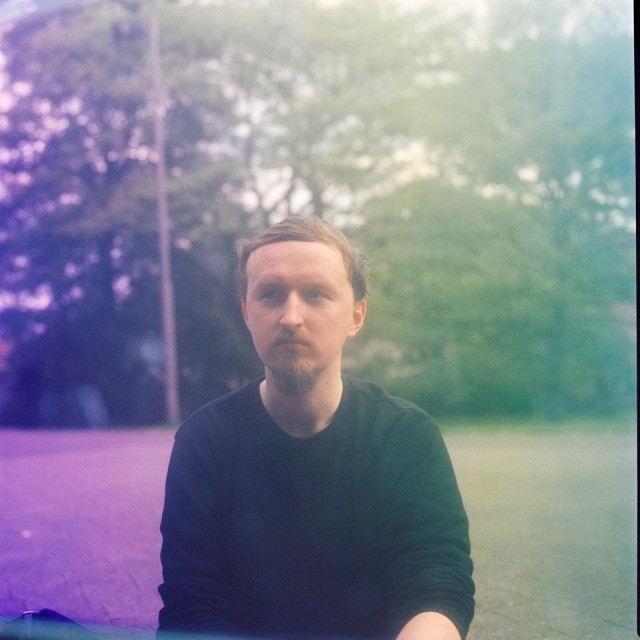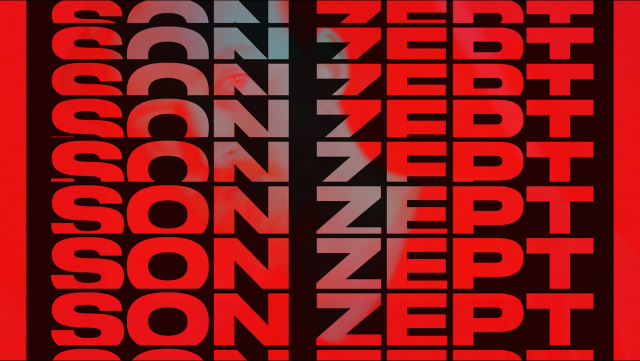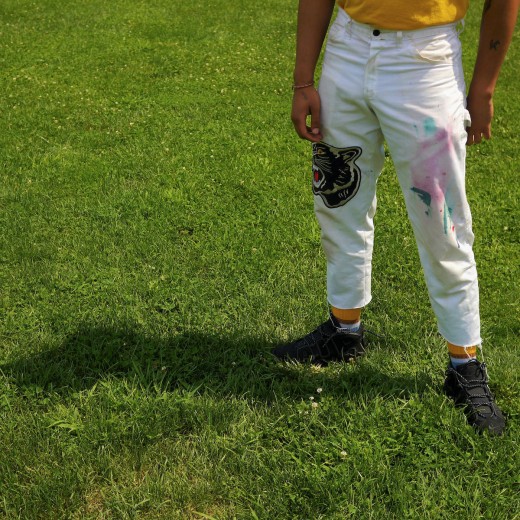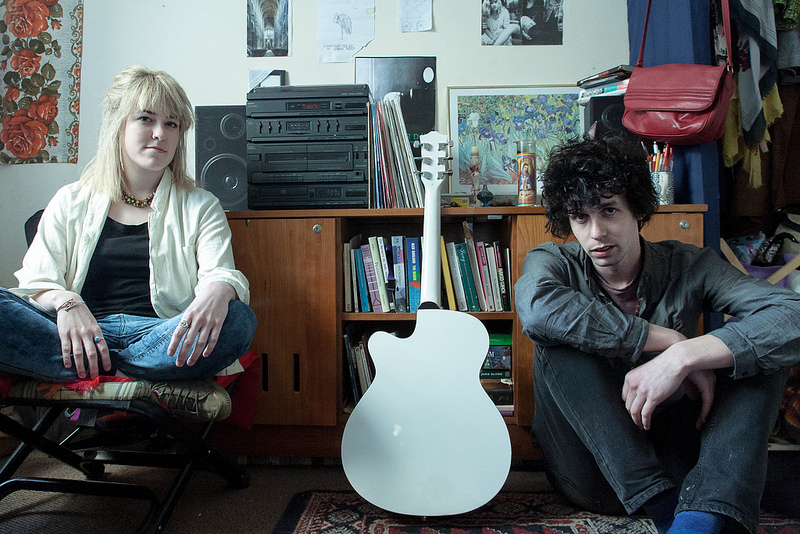A couple of weeks ago, we premiered Son Zept‘s 40-minute debut EP, released through Belfast experimental electronic imprint Resist. Ahead of it, we met with Liam McCartan to discuss his involvement in Belfast’s Sonic Arts Research Centre – where he’s currently composing for a PhD – and Resist, where he’s been instrumental in its growth from club night to label, alongside founders Koichi Samuels & Helena Hamilton – where in terms of enabling his prolificity, “it’s a constant dialogue – we already have a 2 or 3 EPs idea”.
Being staunchly individual, but instrinsically linked to both institutions, the Q2B EP strikes a midpoint between the bodies he’s most involved with and McCartan is aware of how ideology fits into the process – not that anyone could ever accuse him of being in any way a creative ideologue. On the contrary – the throughline is Son Zept; an ingrained sense of rhythmic dynamism. It’s equal turns dense & hauntological, conjuring trance flashbacks in some power-ambient symbiosis, dense polypatterned jungle-meets-techno. Live, he’ll cap off a set with an infinity BPM blast beat expulsion that shares more with black metal than dance.
We sat down with McCartan in what turned out to be a lengthy chat about creating music for PhD & club settings, metamodernism, deconstructionism and Cher.
This idea of a ‘Belfast Sound’ has never been more redundant due to the heteroglot of new ideas being pressed into the place. With the city more internationally connected than our parents could have imagined even twenty years ago, NI’s artistic sector appears to be moving forward very gradually despite itself, and SARC & Resist seem to both feed into this idea. Many of the most exciting artists don’t sound specifically tied to NI, yourself included. Why do you think that is?
The internet’s given us universality, but it’s more about what the individual does with how they make their music. Mark Fischer talks about ‘The Slow Cancellation of the Future’, Kraftwerk’s vision of the future – that we once thought about it and it still isn’t real, means that we can’t really invent a new future. They say all we’re stuck in now is either pastiche or serious parody. Like, we’ve grown up with the ironic humour of stuff like the Simpsons and that leads us to think everything exists to be made fun of. That’s cynical, and I’d rather someone who serves me coffee be nice than an asshole. But now the movement beyond that now is metamodernism, which I’m an advocate for. It feels like it fits Belfast.
Before, the cool person was the one with a cigarette not giving a fuck, saying it’s all crap – but now, it’s the person that’s passionate person that goes “I fucking love this. I think that’s amazing”. Sincerity is meta-modernism. The mix between the faith of modernism and deconstructionist attitude in post-modernism. After the First World War, the feeling was that the world had conquered evil, so you get a modernist like Schoenberg having faith in the listener so he can invent a new harmonic system. Then World War 2 happens and you go “Aw shit, evil can be beaten but can’t be stomped out forever” and everyone gets really cynical. You go down until eventually humour is completely ironic/cynical and musical genres are based on cynicism like grunge.
On that note, you’ve been described as deconstructed club music. Do you see that as an extension of yourself, or is it more an academic process?
Deconstructed electronic music, but personal reassembly is a big thing for me. You can say you’re deconstructing, but it’s not saying much about what you’re doing after you do that, but the personal reassembly thing is going “what’s me?”
Deconstructing everything is great, you can pull genres apart and that’s how you get new music. This idea that any text can be analysed in many millions of interpretations from what went before – had we not thought of it normally before? What I say about it is it’s deconstructed electronic music, electroacoustic, uh, nearly hauntological, uh, “whatever you want to call it”.
And with the Son Zept thing, it’s a way to celebrate what you like in music. The EP is variety all over, my electronic sensibilities – I don’t know, well, I can obviously add this little splurt in my head of trusting my opinion on it rather than going to other people – if I couldn’t define it, then I thought I was doing something good.
You have to think how much we’re accepting of different sounds. People haven’t acknowledged that the more American-style dubstep was a moment where literally synthesised noise became good shit to a lot of people – something that moved from the hard underground, into acceptable to the mass ear in pop songs.
So, obviously your own musical inclinations are essential, but how has the academic setting of SARC informed your music?
It’s hard to look broadly at it while you’re still in it, but probably the idea of sound being completely malleable, that it’s not concrete. Like the distance the sounds on the EP have travelled from their original creation…
And you’re not trapped, if you think of authenticity – I am I allowed to take this sound? Am I allowed to sound like this B-boy electro 80s scene – can I take those drums? Maybe, maybe not, so you morph it through a granulizer and shape it into a fucked up synth line, or more again.
When I was doing the electroacoustic side of it, using all these different things that provide you with notions of what that sounds like, and what that means and the connection with memory. You want to distance yourself as a composer or producer and become a listener to your track. Dennis Smalley – his idea of the technological ear and the compositional ear – you or I might hear something and go “there’s a spring reverb” – that changes your listening experience more than you think, so some processes are a little bit more articulated and a little more hidden.
SARC is a bit of an anomaly for Belfast. It’s an incubator. I’m making all these pieces for a PhD at the moment and I’m going to release them to the world. The EP is variety all over, my electronic sensibilities, I can obviously add this little splurt in my head of trusting my opinion on it rather than going to other people but I thought, if I couldn’t define it, then I thought I was doing something good. And with the Son Zept thing, it’s a way to celebrate what I like in music.
What is it that you’re exploring at SARC, and how linked is it to your own artistic output?
My first thing was the divide between electroacoustic or ‘academic music’ and electronic music – but that’s way too wide. To try and tell academia that they don’t favour low repetitive rhythm, that’s a losing battle. You start talking about why doesn’t electroacoustic music feature rhythms.
You get into the law in the 90s, of skewed repetitive rhythms. They could shut down raves if there was a repetitive rhythm, so what Autechre did, beautifully, was release a rave track that says “this contains no repetition”. It was technically sheet music, so when you played it, you could have a lawyer and a musicologist beside you and play it out at a rave and they couldn’t shut you down, because technically it fucking worked. It raved out but never truly repeated.
Music gets internalised. People threw parties because of rhythm, and the drugs – that whole thing – the weird thing now is that electronic music is one of the most liked genres in the world, but people aren’t dancing all the time. And you don’t need to go to a place where dancing’s available. Most of it’s listened to. This is rhythm, and to say that rhythm invokes dancing, and needs to have a function is really strange. I had to throw that kind of thing away and stop trying to address the problems with the academy – honestly, it doesn’t go anywhere. They heard a really hard beat, they thought “aw dance music” and could easily discredit it without addressing the concepts.
Now, it’s about temporality from the micro to macro. Can you go down a nanosecond, and can you evoke all these things? It’s nanosecond differences in rhythm and perception, then when you go up higher, it’s all about Pythagorean intervalic ratio. How pitch is related to rhythm, and the macro is about memory – you’re evoking stuff from the past that you might not even be fully in. I made a piece that was 10th century organum I was trying to evoke, but I’m making it all using one long held E on a guitar, distorted and synthesised with lots of organs & bells, so it’s religious.
A lecture I watched on stroke victims and music and the neurological effects music has on us, said that “during intense musical responses, the short term memory locks down and the mind stops thinking about the future.” Not “when am I gonna get that thing?” You don’t think about what’s happening around you, or plan what’s going to happen that doesn’t involve the music. But the long-term memory stays, so you’re slowly embracing all these memories behind you. Emotion in music is all locked in memory, and we are all our own little dens of memories.
Were there any intentions to have this music played in any kind of acousmatic space?
It’s not whether or not it’s intended, I’m not actually thinking about that, positing myself for driving in the dark, or that people have to sit down and listen to it – I am all about anyone’s reaction is fully credible. There’s some pieces that are fully intended for space – I realise there’s an academic trajectory and there’s a club trajectory, but my real want is it all, really – I’d like it to live in both. What you get is what you get, and that’s just what I want to celebrate.
This, I think should be set in everyone’s creative heads: The gig begins the second you’ve thought about buying a ticket, and the journey affects all the tones that you’re hearing. I wouldn’t want to describe what I’m doing before people hear the music – it shapes completely how you’re viewed and the whole process that goes into it.
Resist is unique in Belfast in that it bridges a huge gap in Belfast between art space and club night. Can you tell us more about its operation, and the depth of their creative involvement with your releases?
I just keep giving Koichi things. It’s a constant dialogue, like “I made a thing today, is it cool?” We already have a 2 or 3 EPs idea. This passion, naivety, sincerity – we’re becoming metamodernists. And the people who care are the people who are like “I will listen to anything.” They’re the people who are getting shit done – and should be. Love the influence and let it bleed. I made a tune the other day where I thought “I really want to make a hard euphoric post-rock thing that uses blast beats”. Just the notion of blast beats in electronic music. It’s like 230 BPM. It’s really fuckin’ intense.
Look, experimental electronic is pretty all-encompassing. Lorenzo Senni was fully deconstructed trance, Paul Stapleton builds his own instruments and is doing his electric bonsai tree improvisations. We had Shiva Feshareki doing live turntablism – she’d just played the Proms and is going to do her debut album on Resist. That’s the bridge nailed for us. Koichi put “What defines and divides” as our thing, because we didn’t want to be like “this is us, we book techno, don’t think”. No no no – we book people and then they play, and it’s hopefully a new sense of electronic music. I’m all about ‘what you get is what you get’.
Yeah, it’s tough to walk that tightrope without falling into elitist territory (from the outside, at least) but Resist seems to be able to accommodate and invoke a rave or space-out as it probes in challenging new territory.
We’re all sincere about what we like at Resist, and we only work with people we love. To make that more serious, at the end of the night, we have to go “we’re not these elite beings – here’s Cher”. You were in it for that weird sound trip – your mind’s been polarised with all this weird instrumentation all night, then we end with Cher’s ‘Believe’, and you leave with smiles, and dancing about love, and auto-tuned Cher.
It’s just this lovely, sugary pop – this is us saying we’re sincere, we’re still lovely. I think it means more to Resist than what people might give it credit for – just the idea of “don’t take yourself so seriously”. So that’s a ritual. We have to do it every time, because it brings you back.
Can you talk us through some of the tracks on your EP?
‘Neverberry’ is polyrhythm madness, and by extension – and I haven’t thought of another word for it – polypatternism. It’s the act of maybe a seven-bar phrase over a six-bar phrase over a four-bar bass loop, and none of those fall on the same grid. Beat one always feels like beat one, but melodies are going over on varying lengths. Maybe it’s the Autechre technique of not technically repeating, but the soundscape is still familiar so you’re not flying away, incomprehensibly exhausting that polyrhythmic aspect to a point beyond enjoyability. Because then, you’ve distanced yourself too far with the technological aspect and need to get back to the listener. There is a lot of chance in what I do – I’m going in and not being fully certain about the things.
‘Encola‘ – I will say there’s a lot of composition. You’ll be lucky to ever find a 4 to the floor in my thing, although it has a role, but I’ve always thought that if you want to do that, you need a reason. I always make use of the Baltimore rhythm – it’s like a lovely little mini-syncopation, but my patterns have variance everywhere and it doesn’t actually fully land on it, but come back to the point where the beginning is not the beginning again, but it’s grounding you so you’re closer to a drum circle, where people are kind of fucking with it so you’re not automated, constantly regular.
‘Queborno’ is all over the place with sound sources. Some of those are real riff based, but come from image synthesis. There’ll be a synthesiser that goes across the image and uses the spectral content to resample. I’ll do endless resampling. I’ll take a thing – a text document and turn into an mp3 – rerecord it, stick it back into a granulizer, then see where I’m going. I’ll make an instrument – maybe a synthesised instrument out of cable wire noise and use that as a melody device. I’ve been told even the way I talk even sounds like I’ve granulated my voice – I’ve gone way too deep here.
For ‘Rave Memory‘, I had to think of this concept of the listener’s sonic memory; like, can I instantly incite a whole genre and era with just a snare? When you take that and slam it into another sound source and use different modes of synthesis to twist it, so your mind gets an emotional response. ‘Rave Memory’ does it a bit. It’s a trance buildup over 8 minutes, and everything is emotionally potent. Stretching a 30 second build-up, you can create a fake memory that is still attached to you – you know those videos you see, like “Mr Brightside but heard in the next room” – why does that feel so sad? There are recollections of that song that many people possess but it’s been taken and twisted. You almost create a false nostalgic experience of maybe a party when you’re hearing ‘Mr Brightside’ – someone knocks on the bathroom door and someone’s asking “are you alright?” and you’re looking at your phone. It’s a memory that’s not real but is strongly felt. That can be explored everywhere.
The Q2B EP is out now on digital & 12″ vinyl formats via Bandcamp. Watch Christopher Steenson’s audio-reactive video for ‘Neverberry’ below:






